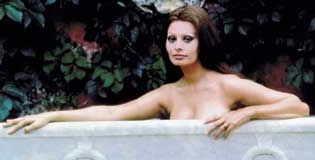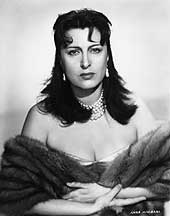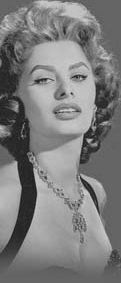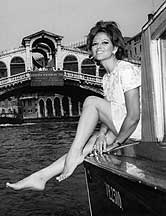
We're an all volunteer website and need your help to keep going. Here are five ways you can contribute: 1 Donate 2 Buy something 3 Submit a story 4 Volunteer 5 Advertise

New in the gift shop, virtualitalia.com logo wear and use items! 
|
PLEASE NOTE: We are experiencing unexpected
technical difficulties caused by our web host. We apologize for
the inconvenience. During your visit you may experience service
and page interruptions - we are in the process of fixing everything and hope to be
fully back on our feet soon.
italian movie goddesses
Sophia Loren's role in 1951's Gold of Naples capped her rise to stardom in the Italian cinema and launched her toward global triumph. But the performance represented more than a personal victory and the impression she made extended beyond the boundaries of the screen. Sophia, along with her screen sisters Anna Magnani, Gina Lollobrigida and Claudia Cardinale, projected a new kind of cinematic sexuality. The Italian screen sirens were women of astonishing physical beauty, but they were no mere ornaments. The characters they brought to life used their femininity as a source of strength. They were sexually passionate, fiercely independent and intelligent, with strong moral principles. At the same time, filmmakers elsewhere in Europe and in the United States were busy creating new paradigms of feminine sexuality. France gave us bombshells like Brigitte Bardot and Ursula Andress. Marilyn Monroe and Jayne Mansfield embodied new American ideas about sexuality. Like their counterparts, the Italian sirens had beauty and raw sex appeal to spare, but it was their strength as much as their beauty that set them apart even when they played damsels in distress, they did not need rescuing. As part of our celebration of Italian passion, F&L Primo pays tribute to these divas of the silver screen. These women did as much in our century to define our sense of beauty, character and style as the great painter Modigliani did in his. At the peak of their fame, these women projected a new kind of femininity in an astonishing array of films from Roberto Rossellini's neo-realistic films of defeat and redemption, to the light-hearted sex comedies of Vittorio DeSica, to the hallucinogenic autobiographical meditations of Federico Fellini.
Bitter Roots, Bright Harvest By war's end in 1945, Italy was ruined. The war cost Italy 410,000 lives, nearly one-fifth of them civilians. As is usually the case, it was the men who had planned the war, fought it and lost it. In the cities and countryside as well as in the cinema it was left to the women to pick up the pieces. In the face of such destruction and despair, it was natural that the movies turned from romanticism and fantasy to examine bitter truths about human nature. Italian filmmakers who had fought with the resistance laid down their arms and picked up their cameras to explore their country's humiliations, to challenge the beliefs that led to its defeat, and to celebrate its resolve as it crumbled and then rebuilt itself. Rossellini's Open City told the story of the Italian resistance against the Germans in the latter stages of the war. The resilience that kept the resistance alive in the face of incredible odds, Rossellini was telling his audience would also be needed to restore a nation. The film is notable for another reason: It introduced Anna Magnani to global movie audiences and sparked an era in which the great Italian sirens would rule the screen.
Anna Magnani Pita, portrayed by Magnani, exudes a dignified, ethereal beauty as she joins the men in fighting the Nazis. So great is her dedication to the cause and her loyalty to her husband that she breaks free of German soldiers to chase after the truck that is taking him to jail and, perhaps, death. As Pita sprints down a ruined Roman boulevard, a German soldier coolly levels his rifle and shoots her. She dies in the street in the arms of partisans. Open City sparked a movement in Italian cinema called neo-realism, so named because filmmakers were shooting films about events almost at the same time the events were taking place and because their films showed Italian society as it was, without romanticism. The film made Anna an overnight star after 20 years of hard work in front of the cameras. Acclaim did not slow Anna down and she continued to star in films at a prodigious rate. One of her best performances came in Luchino Visconti's 1951 production of Bellissima, in which she portrays Maddalena Cecconi, a one-of-a-kind stage mother. Soon she would be a star in America. Open City inspired dramatist Tennessee Williams to write The Rose Tattoo and he had Anna in mind to play the lead from the start. She did not wish to play the role on Broadway, but she did appear opposite Burt Lancaster in the 1955 film adaptation, winning an Oscar for her portrayal of Serafina Delle Rose. Unlike many of the other Italian sirens, Anna was not enamored with Hollywood and remained at home in the Italian cinema. Whether playing a mother, a madwoman or a prostitute, Anna radiated sincerity and dignity on the screen. The woman who fans called Nannarella died in 1973, one year after making her final film, Federico Fellini's Roma.
Gina Lollobrigida Most of Gina's noteworthy films were made for Italian audiences; it was her beauty rather than her acting that caught the rest of the world's attention. While Sophia Loren embodied Italian womanhood to moviegoers in the United States, Italians declared Gina to be their ideal woman, as evidenced by yet another nickname: Gina Nazionale. That is not to say, however, that audiences outside of Italy did not appreciate what Gina offered. Come September, in which she starred opposite Rock Hudson, won the 1961 Golden Globe award as the world's favorite picture. Lollobrigida did not run from fame but she did not embrace it either. "Popularity," she said, "has a bright side, it unlocks many doors. But the truth is that I don't like it very much because it changes the private life into a very small thing." As an escape from her celebrity, Gina took up photography and became an accomplished artist. Both Paul Newman and Salvador Dali posed for her and in 1973 she published a collection of her work, Italia Mia. Gina still makes appearances at Cannes and other film festivals, but she largely retired from acting after a stint on the television show "Falcon Crest" in 1985. Given the veneration she received from her fellow Italians, it is hard to believe that Lollo's big break came when she finished third in the Miss Italy contest. She may be retired from the screen, but her sex appeal endures. "I've had many lovers and still have romances," she said in a recent interview. "I am very spoiled. All my life, I've had too many admirers."
Sophia Loren Whether she played in dramas, romances or light comedies, Sophia invariably portrayed women who were not to be trifled with. In 1961's Two Women, for which she won an Academy Award, she wrenchingly played a woman determined to survive and nurture her daughter in war-torn Italy. The two women face danger and deprivation; ultimately, they are both raped by soldiers. Sophia's character despairs and is disillusioned as her life spins out of control but she is never, ever, defeated. Perhaps Sophia could relate to such characters because she grew up hungry in Naples, a fact that in part accounted for the name she was called by the other children in her Pozzuoli neighborhood: Sophia Stuzzicadenti (Sophia the Toothpick). If ever a youthful nickname did not prophesize the destiny of its bearer, this was it! Characteristic of her modesty and wit, a grown-up Sophia once told a star-struck interviewer, "Everything you see I owe to spaghetti." Sophia's success and persona spring directly from her upbringing. "The two big advantages I had at birth," she says, "were to have been born wise and to have been born in poverty." Sophia's off-screen life rivaled her film roles for drama. She waited for years for her married mentor, director Carlo Ponti, who had discovered her in a beauty pageant, to win an annulment of his marriage. In the meantime, she was linked to many famous leading men, including Cary Grant, her co-star in the drama The Pride and the Passion and in the light comedy Houseboat. In order to marry lawfully, Loren and Ponti became French citizens in 1966. Approaching 70, Sophia Loren is as beautiful as ever and as successful. She still occasionally acts in films, such as Grumpier Old Men with Jack Lemmon and the late Walter Matthau (1995), and has also penned a best-selling autobiography and several cookbooks. In a British poll last year, Sophia was named the most beautiful woman of the millennium. Sophia Loren was never afraid to challenge herself or others' expectations of her. "Mistakes," she once said, "are part of the dues one pays for a full life."
Claudia, originally billed as Italy's answer to Brigitte Bardot, followed Anna Magnani, Gina Lollobrigida and Sophia Loren onto the world stage. Born in Tunisia of Sicilian parents, Claudia's mod, sultry looks (a "panthress" one reviewer called her) were made for the Age of Chic. Her big break came in 1963 when she starred in one of the masterpieces of the world cinema, Fellini's 8-1/2 (believed by many critics to be the finest film ever made period). The Italian film industry could not hold Claudia, just as it could not hold the sexy Italian actresses that preceded her. She made films in Europe and Hollywood and became a global celebrity. Her role in The Pink Panther helped launch her to international acclaim. Like the other great Italian heroines, when she played a damsel in distress she often rode to her own rescue. Sweetness and scheming characterize Claudia's role in Sergio Leone's great 1968 Spaghetti Western, Once Upon a Time in the West, in which she starred with Charles Bronson, Henry Fonda and Jason Robards. She also more than held her own with some formidable male leads in one of the most macho movies ever made 1966's The Professionals, which co-starred Lee Marvin, Burt Lancaster, Robert Ryan, Jack Palance and Woody Strode. Following her American success in the 1960s, Claudia made most of her films in Europe. She remains active in the cinema.
Roll Credits
|
© 1998-2005 by virtualitalia.com unless otherwise noted
 The image captures the essence of the postwar Italian screen siren:
Angrily rejecting her lover, an otherworldly Sophia Loren stalks down a cobbled street,
throwing a defiant look over her shoulder as the camera lingers on her swaying hips.
The image captures the essence of the postwar Italian screen siren:
Angrily rejecting her lover, an otherworldly Sophia Loren stalks down a cobbled street,
throwing a defiant look over her shoulder as the camera lingers on her swaying hips.








 As Germany fought to retain control of Rome in 1943-1944, Roman citizens faced a choice:
submit to the conquerors or join the fight to rid Europe of fascism, in whose rise the
Italians had played no small part. Many chose to fight. By fighting the Germans, the
Italians were fighting to reclaim individual and national self-respect. Open City depicted
the battle for Rome between the German army and over-matched resistance fighters.
As Germany fought to retain control of Rome in 1943-1944, Roman citizens faced a choice:
submit to the conquerors or join the fight to rid Europe of fascism, in whose rise the
Italians had played no small part. Many chose to fight. By fighting the Germans, the
Italians were fighting to reclaim individual and national self-respect. Open City depicted
the battle for Rome between the German army and over-matched resistance fighters.
 With her earthy looks and short "tossed salad" hairdo, "Lollo," as she was known to her
fans, was a perfect fit for one of her most enduring roles: the exotic Esmerelda in The
Hunchback of Notre Dame. But it was another film that gave Luigina Lollobrigida an even
more flattering nickname: The Most Beautiful Woman in the World.
With her earthy looks and short "tossed salad" hairdo, "Lollo," as she was known to her
fans, was a perfect fit for one of her most enduring roles: the exotic Esmerelda in The
Hunchback of Notre Dame. But it was another film that gave Luigina Lollobrigida an even
more flattering nickname: The Most Beautiful Woman in the World. Sophia Loren, the greatest of all the Italian movie divas, also got her start in film in
the bleak postwar years, and while some of her early earthy roles recalled Magnani's stoic
characters, Loren quickly metamorphosed into a full-blown sex symbol. Her dark, almost
feline features and sculpted curves, combined with an aggressive sexuality, captivated
audiences worldwide.
Sophia Loren, the greatest of all the Italian movie divas, also got her start in film in
the bleak postwar years, and while some of her early earthy roles recalled Magnani's stoic
characters, Loren quickly metamorphosed into a full-blown sex symbol. Her dark, almost
feline features and sculpted curves, combined with an aggressive sexuality, captivated
audiences worldwide.
 Claudia Cardinale
Claudia Cardinale